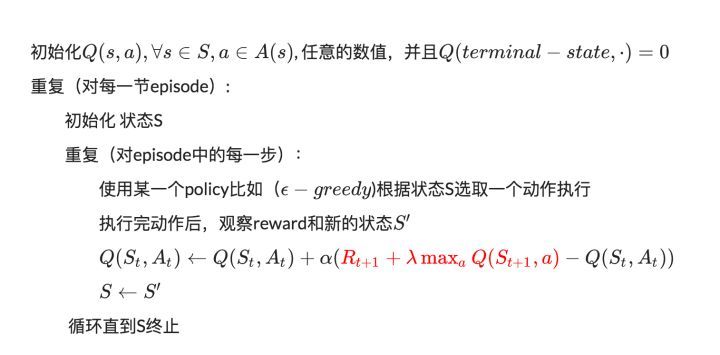【强化学习】python 实现 q-learning 例一
本文作者:hhh5460
本文地址:https://www.cnblogs.com/hhh5460/p/10134018.html
问题情境
-o---T
# T 就是宝藏的位置, o 是探索者的位置
这一次我们会用 q-learning 的方法实现一个小例子,例子的环境是一个一维世界,在世界的右边有宝藏,探索者只要得到宝藏尝到了甜头,然后以后就记住了得到宝藏的方法,这就是他用强化学习所学习到的行为。
Q-learning 是一种记录行为值 (Q value) 的方法,每种在一定状态的行为都会有一个值 Q(s, a),就是说 行为 a 在 s 状态的值是 Q(s, a)。s 在上面的探索者游戏中,就是 o 所在的地点了。而每一个地点探索者都能做出两个行为 left/right,这就是探索者的所有可行的 a 啦。
致谢:上面三段文字来自这里:https://morvanzhou.github.io/tutorials/machine-learning/reinforcement-learning/2-1-general-rl/
要解决这个问题,下面的几个事情要先搞清楚:
0.相关参数
epsilon = 0.9 # 贪婪度 greedy
alpha = 0.1 # 学习率
gamma = 0.8 # 奖励递减值
1.状态集
探索者的状态,即其可到达的位置,有6个。所以定义
states = range(6) # 状态集,从0到5
那么,在某个状态下执行某个动作之后,到达的下一个状态如何确定呢?
def get_next_state(state, action):
'''对状态执行动作后,得到下一状态'''
global states # left, right = -1,+1 # 一般来说是这样,不过要考虑首尾两个位置
if action == 'right' and state != states[-1]: # 除最后一个状态(位置),皆可向右(+1)
next_state = state + 1
elif action == 'left' and state != states[0]: # 除最前一个状态(位置),皆可向左(-1)
next_state = state -1
else:
next_state = state
return next_state
2.动作集
探索者处于每个状态时,可行的动作,只有"左"或"右"2个。所以定义
actions = ['left', 'right'] # 动作集。也可添加动作'none',表示停留
那么,在某个给定的状态(位置),其所有的合法动作如何确定呢?
def get_valid_actions(state):
'''取当前状态下的合法动作集合,与rewards无关!'''
global actions # ['left', 'right'] valid_actions = set(actions)
if state == states[-1]: # 最后一个状态(位置),则
valid_actions -= set(['right']) # 去掉向右的动作
if state == states[0]: # 最前一个状态(位置),则
valid_actions -= set(['left']) # 去掉向左
return list(valid_actions)
3.奖励集
探索者到达每个状态(位置)时,要有奖励。所以定义
rewards = [0,0,0,0,0,1] # 奖励集。只有最后的宝藏所在位置才有奖励1,其他皆为0
显然,取得状态state下的奖励就很简单了:rewards[state] 。根据state,按图索骥即可,无需额外定义一个函数。
4.Q table
最重要。Q table是一种记录状态-行为值 (Q value) 的表。常见的q-table都是二维的,基本长下面这样:
 (注意,也有3维的Q table)
(注意,也有3维的Q table)
所以定义
q_table = pd.DataFrame(data=[[0 for _ in actions] for _ in states],
index=states, columns=actions)
5.环境及其更新
考虑环境的目的,是让人们能通过屏幕观察到探索者的探索过程,仅此而已。
环境环境很简单,就是一串字符 '-----T'!探索者到达状态(位置)时,将该位置的字符替换成'o'即可,最后重新打印整个字符串!所以
def update_env(state):
'''更新环境,并打印'''
global states env = list('-----T')
if state != states[-1]:
env[state] = 'o'
print('\r{}'.format(''.join(env)), end='')
time.sleep(0.1)
6.最后,Q-learning算法
Q-learning算法的伪代码

中文版的伪代码:

图片来源:https://www.hhyz.me/2018/08/05/2018-08-05-RL/
Q value的更新是根据贝尔曼方程:
$$Q(s_t,a_t) \leftarrow Q(s_t,a_t) + \alpha[r_{t+1} + \lambda \max _{a} Q(s_{t+1}, a) - Q(s_t,a_t)] \tag {1}$$
好吧,是时候实现它了:
# 总共探索13次
for i in range(13):
# 0.从最左边的位置开始(不是必要的)
current_state = 0
#current_state = random.choice(states) # 亦可随机
while current_state != states[-1]:
# 1.取当前状态下的合法动作中,随机(或贪婪)地选一个作为 当前动作
if (random.uniform(0,1) > epsilon) or ((q_table.ix[current_state] == 0).all()): # 探索
current_action = random.choice(get_valid_actions(current_state))
else:
current_action = q_table.ix[current_state].idxmax() # 利用(贪婪)
# 2.执行当前动作,得到下一个状态(位置)
next_state = get_next_state(current_state, current_action)
# 3.取下一个状态所有的Q value,待取其最大值
next_state_q_values = q_table.ix[next_state, get_valid_actions(next_state)]
# 4.根据贝尔曼方程,更新 Q table 中当前状态-动作对应的 Q value
q_table.ix[current_state, current_action] += alpha * (rewards[next_state] + gamma * next_state_q_values.max() - q_table.ix[current_state, current_action])
# 5.进入下一个状态(位置)
current_state = next_state print('\nq_table:')
print(q_table)
好了,这就是大名鼎鼎的Q-learning算法!
注意,贝尔曼方程中,取奖励是用了 rewards[next_state],再强调一下:next_state
当然,我们希望能看到探索者的探索过程,那就随时更新(打印)环境即可:
for i in range(13):
#current_state = random.choice(states)
current_state = 0 update_env(current_state) # 环境相关
total_steps = 0 # 环境相关 while current_state != states[-1]:
if (random.uniform(0,1) > epsilon) or ((q_table.ix[current_state] == 0).all()): # 探索
current_action = random.choice(get_valid_actions(current_state))
else:
current_action = q_table.ix[current_state].idxmax() # 利用(贪婪) next_state = get_next_state(current_state, current_action)
next_state_q_values = q_table.ix[next_state, get_valid_actions(next_state)]
q_table.ix[current_state, current_action] += alpha * (reward[next_state] + gamma * next_state_q_values.max() - q_table.ix[current_state, current_action])
current_state = next_state update_env(current_state) # 环境相关
total_steps += 1 # 环境相关 print('\rEpisode {}: total_steps = {}'.format(i, total_steps), end='') # 环境相关
time.sleep(1) # 环境相关
print('\r ', end='') # 环境相关 print('\nq_table:')
print(q_table)
7.完整代码
'''
-o---T
# T 就是宝藏的位置, o 是探索者的位置
'''
# 作者: hhh5460
# 时间:20181217
import pandas as pd
import random
import time epsilon = 0.9 # 贪婪度 greedy
alpha = 0.1 # 学习率
gamma = 0.8 # 奖励递减值 states = range(6) # 状态集。从0到5
actions = ['left', 'right'] # 动作集。也可添加动作'none',表示停留
rewards = [0,0,0,0,0,1] # 奖励集。只有最后的宝藏所在位置才有奖励1,其他皆为0 q_table = pd.DataFrame(data=[[0 for _ in actions] for _ in states],
index=states, columns=actions) def update_env(state):
'''更新环境,并打印'''
global states env = list('-----T') # 环境,就是这样一个字符串(list)!!
if state != states[-1]:
env[state] = 'o'
print('\r{}'.format(''.join(env)), end='')
time.sleep(0.1) def get_next_state(state, action):
'''对状态执行动作后,得到下一状态'''
global states # l,r,n = -1,+1,0
if action == 'right' and state != states[-1]: # 除非最后一个状态(位置),向右就+1
next_state = state + 1
elif action == 'left' and state != states[0]: # 除非最前一个状态(位置),向左就-1
next_state = state -1
else:
next_state = state
return next_state def get_valid_actions(state):
'''取当前状态下的合法动作集合,与reward无关!'''
global actions # ['left', 'right'] valid_actions = set(actions)
if state == states[-1]: # 最后一个状态(位置),则
valid_actions -= set(['right']) # 不能向右
if state == states[0]: # 最前一个状态(位置),则
valid_actions -= set(['left']) # 不能向左
return list(valid_actions) for i in range(13):
#current_state = random.choice(states)
current_state = 0 update_env(current_state) # 环境相关
total_steps = 0 # 环境相关 while current_state != states[-1]:
if (random.uniform(0,1) > epsilon) or ((q_table.ix[current_state] == 0).all()): # 探索
current_action = random.choice(get_valid_actions(current_state))
else:
current_action = q_table.ix[current_state].idxmax() # 利用(贪婪) next_state = get_next_state(current_state, current_action)
next_state_q_values = q_table.ix[next_state, get_valid_actions(next_state)]
q_table.ix[current_state, current_action] += alpha * (rewards[next_state] + gamma * next_state_q_values.max() - q_table.ix[current_state, current_action])
current_state = next_state update_env(current_state) # 环境相关
total_steps += 1 # 环境相关 print('\rEpisode {}: total_steps = {}'.format(i, total_steps), end='') # 环境相关
time.sleep(2) # 环境相关
print('\r ', end='') # 环境相关 print('\nq_table:')
print(q_table)
8.真正的最后,效果图



【强化学习】python 实现 q-learning 例一的更多相关文章
- 深度强化学习(DQN-Deep Q Network)之应用-Flappy Bird
深度强化学习(DQN-Deep Q Network)之应用-Flappy Bird 本文系作者原创,转载请注明出处:https://www.cnblogs.com/further-further-fu ...
- 机器学习之强化学习概览(Machine Learning for Humans: Reinforcement Learning)
声明:本文翻译自Vishal Maini在Medium平台上发布的<Machine Learning for Humans>的教程的<Part 5: Reinforcement Le ...
- 【转】【强化学习】Deep Q Network(DQN)算法详解
原文地址:https://blog.csdn.net/qq_30615903/article/details/80744083 DQN(Deep Q-Learning)是将深度学习deeplearni ...
- 深度强化学习(Deep Reinforcement Learning)入门:RL base & DQN-DDPG-A3C introduction
转自https://zhuanlan.zhihu.com/p/25239682 过去的一段时间在深度强化学习领域投入了不少精力,工作中也在应用DRL解决业务问题.子曰:温故而知新,在进一步深入研究和应 ...
- [Reinforcement Learning] 强化学习介绍
随着AlphaGo和AlphaZero的出现,强化学习相关算法在这几年引起了学术界和工业界的重视.最近也翻了很多强化学习的资料,有时间了还是得自己动脑筋整理一下. 强化学习定义 先借用维基百科上对强化 ...
- Deep Learning专栏--强化学习之从 Policy Gradient 到 A3C(3)
在之前的强化学习文章里,我们讲到了经典的MDP模型来描述强化学习,其解法包括value iteration和policy iteration,这类经典解法基于已知的转移概率矩阵P,而在实际应用中,我们 ...
- 深度强化学习(DRL)专栏(一)
目录: 1. 引言 专栏知识结构 从AlphaGo看深度强化学习 2. 强化学习基础知识 强化学习问题 马尔科夫决策过程 最优价值函数和贝尔曼方程 3. 有模型的强化学习方法 价值迭代 策略迭代 4. ...
- (转) 深度强化学习综述:从AlphaGo背后的力量到学习资源分享(附论文)
本文转自:http://mp.weixin.qq.com/s/aAHbybdbs_GtY8OyU6h5WA 专题 | 深度强化学习综述:从AlphaGo背后的力量到学习资源分享(附论文) 原创 201 ...
- 强化学习论文(Scalable agent alignment via reward modeling: a research direction)
原文地址: https://arxiv.org/pdf/1811.07871.pdf ======================================================== ...
- Ubuntu下常用强化学习实验环境搭建(MuJoCo, OpenAI Gym, rllab, DeepMind Lab, TORCS, PySC2)
http://lib.csdn.net/article/aimachinelearning/68113 原文地址:http://blog.csdn.net/jinzhuojun/article/det ...
随机推荐
- Cache 和 Buffer 都是缓存,主要区别是什么?【转】
作者:Towser 链接:https://www.zhihu.com/question/26190832/answer/32387918 来源:知乎 著作权归作者所有.商业转载请联系作者获得授权,非商 ...
- JMeter乱码常见的解决方案
方法一.直接将JMeter中http请求中Content encoding改为utf-8 方法二.编辑JMeter安装目录:apache-jmeter-3.2\bin中的jmeter.properti ...
- Windows端部署zabbix-agent
一.windows客户端的配置关闭windows防火墙或者开通10050和10051端口(1).关闭防火墙(不推荐直接关闭,测试可以这样做,尤其是最近勒索病毒猛烈)开始—控制面板—windows防火墙 ...
- January 05th, 2018 Week 01st Friday
You can't make decisions based on fear and the possibility of what might happen. 不要因为恐惧未知的可能而妄下决定. P ...
- iOS-单选cell的实现
一.思路 先设置一个chooseCelltag标记(类型为NSIndexPath),然后在点击cell触发的时候,如果tag设置有值,就设置 UITableViewCell *selectedCell ...
- Python进阶(三)
匿名函数 匿名函数有个限制,就是只能有一个表达式,不用写return,返回值就是该表达式的结果.用匿名函数有个好处,因为函数没有名字,不必担心函数名冲突.此外,匿名函数也是一个函数对象,也可以把匿名函 ...
- 【Beta Scrum】冲刺!4/5
1. 今日完成情况 人员 学号 分工 是否完成 完成情况 胡武成 031502610 完成登录注册api,协助web端完成api Y 基本逻辑写完,短信部分还在修改中,预计明天早上便能完成 郭剑南 0 ...
- Xmind破解
原始教程 http://df1551e3.wiz03.com/share/s/3v5l7z2wdQVs2llAUc0C_-n_2cPZVe0kEA2n2iw1Ay1ApF_o
- 如何使用 eclipse进行断点 debug 程序
先给出一段程序,然后通过使用 eclipse 设置断点进行一步步操作看结果 package cn.debug.com; public class Demo18 { public static void ...
- 服务器出现大量的127.0.0.1:3306 TIME_WAIT连接 解决方法 [转载]
netstat -an 192.168.12.13:3306 192.168.12.12:30443 TIME_WAIT 192.168.12.13:3306 192.1 ...
